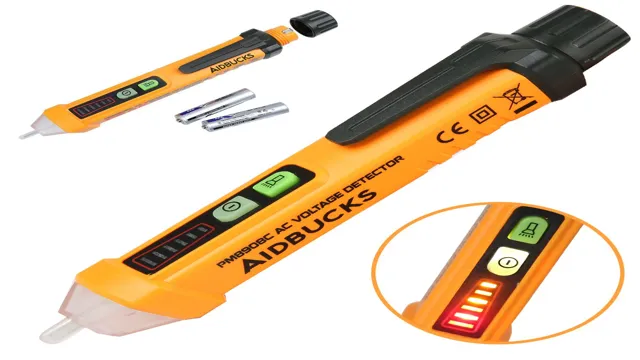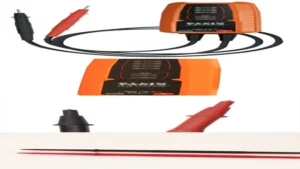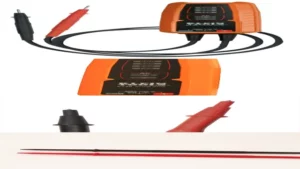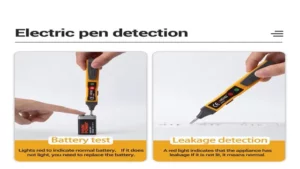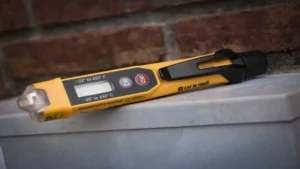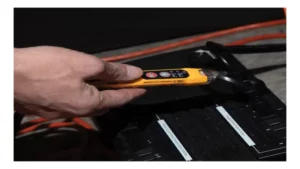As an electrician, your job is all about safety. You know that one mistake could cause a whole lot of trouble. That’s why you take every precaution possible to make sure everything you do is done safely.
And while you might have a whole arsenal of safety tools in your toolbox, there’s one that you might not be taking full advantage of: the non-contact voltage tester. This little device is a must-have for any electrician. It’s a simple tool that lets you determine whether or not there’s live electricity in a wire or an outlet without actually making contact with it.
This can be a game-changer when it comes to staying safe on the job. Think about it like this: If you’re an archaeologist, you wouldn’t go digging without a metal detector, right? And just like a metal detector can help you find hidden treasures, a non-contact voltage tester can help you avoid hidden dangers. With a non-contact voltage tester, you’ll be able to quickly and easily determine if there’s voltage in a wire or outlet, so you know whether or not it’s safe to touch.
And because you don’t have to actually touch anything, there’s no risk of electric shock. Plus, most non-contact voltage testers are compact and easy to use, so you can carry one with you wherever you go. In short, if you’re an electrician, a non-contact voltage tester is a tool you simply can’t do without.
It’s a small investment that can help you stay safe, and that’s something that’s priceless.
What is a Non-Contact Voltage Tester?
A non-contact voltage tester is a tool that can detect the presence of electrical current in wires or circuits without making physical contact. This is done through the use of a sensor that can pick up the electromagnetic field produced by the current. Non-contact voltage testers are often used by electricians to ensure that a wire or circuit is not live before starting work on it.
They are also useful for identifying faulty wiring and detecting voltage fluctuations. What makes them particularly useful is that they are portable and easy to use. Simply hold the tester near a wire or circuit, and it will indicate through a visual or audible cue whether or not there is voltage present.
Overall, a non-contact voltage tester is an essential tool for anyone working with electricity, as it allows for safe and efficient troubleshooting. So the next time you need to check for voltage in a wire or circuit, consider using a non-contact voltage tester to get the job done safely and accurately.
Definition
A non-contact voltage tester is a handy tool that detects the presence of electric voltage without requiring direct contact with the electric conductor. This tool is useful in detecting electrical faults and potential safety hazards in a wide range of electrical systems, including appliances, wires, cables, and outlets. The non-contact voltage tester typically operates by using a sensor that detects the electric field generated by the voltage in the conductor.
When the tester is brought close to the conductor, it gives a visual or audible indication of the voltage’s presence or absence, allowing the user to identify and troubleshoot electrical problems safely and efficiently. With the help of a non-contact voltage tester, you can avoid the risks of electrical shock or damage caused by direct contact with conductors, making it an essential tool for any electrician, homeowner, or DIY enthusiast looking to maintain electrical safety and performance.
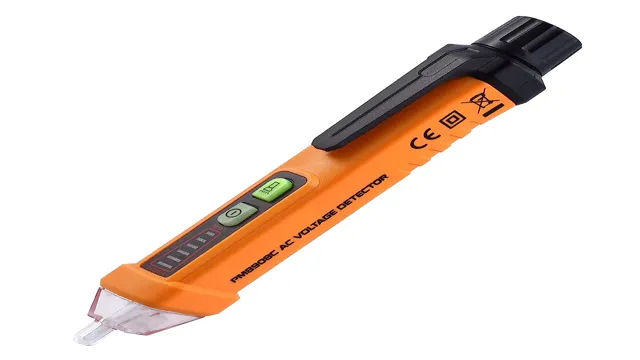
Function
A Non-Contact Voltage Tester is a handy tool that helps to detect the presence of an electrical current without making physical contact with any wires or conductors. Essentially, it works by emitting an electromagnetic field around the object you are testing and if there is a live current present, it will emit a signal to alert you. This tool is particularly useful for electricians or DIY enthusiasts who want to check whether a wire or circuit is live before making repairs or conducting maintenance work.
It can also be used to verify that an electrical circuit has been properly turned off before undertaking any work, thus reducing the risk of electrical shock or injury. Overall, investing in a reliable Non-Contact Voltage Tester can save you time and ensure greater peace of mind when working with electrical systems.
How Does a Non-Contact Voltage Tester Work?
A non-contact voltage tester is a handy tool that allows you to check the presence of a live electrical current without physically touching the wire. Using electromagnetic fields, these testers sense the energy emitted by the electric field surrounding a live wire or cable. The non-contact voltage tester works by using a probe to detect the alternating current (AC) voltage in an electric field.
The probe is held near a wire or outlet, and if the tester detects electricity, it will light up or make a sound to indicate that the wire is live. These testers are extremely accurate and efficient, making them an essential tool for DIY enthusiasts and professionals alike. They are simple to use, lightweight, and safe, making them an excellent investment for anyone who works with electrical systems.
If you are looking for an efficient and safe way to detect live wires, then using a non-contact voltage tester is the way to go.
Detection Method
A non-contact voltage tester is a handy tool to help electricians identify the presence of electrical energy in a wire or cable, without making contact with it. But, have you ever wondered how they work exactly? Well, let’s break it down. These testers operate by utilizing an electromagnetic field that is generated around a live conductor.
They emit an electrical field that is sensitive to changes in the surrounding magnetic field. When the tester comes close to a live wire, the electromagnetic field of the wire induces a voltage in the tester’s probe, which the tool then detects and converts into an audible or visual signal. This signal varies in intensity, and the closer the tester is to the live wire, the stronger the signal will be.
This makes it easy to pinpoint the location of live wires and stay safe on the job. So, the next time you’re working with electrical wires, consider adding a non-contact voltage tester to your toolbox, and take advantage of this innovative technology to ensure your safety and that of those around you.
Types of Non-Contact Voltage Testers
A non-contact voltage tester is a handy device that can be used to detect the presence of voltage without touching the electrical conductor. These testers can be used for a variety of applications, including checking for live wires in electrical circuits, identifying the presence of voltage in equipment, and detecting voltage in outlets and switches. There are different types of non-contact voltage testers available in the market, including pen-style testers, clamp-style testers, and contactless testers.
These testers work by detecting an electric field around the conductor that is carrying an electrical current. The electric field produces a voltage, which can be picked up by the tester. The pen-style testers have a pointed tip that can be used to touch the conductor or be held close to it.
The clamp-style testers have jaws that can be opened to fit around the conductor. The contactless testers are designed to detect the electric field without physically contacting the conductor. In summary, non-contact voltage testers are an essential tool for anyone working with electrical equipment or circuits.
They provide a simple and safe way to detect the presence of voltage without needing to touch the conductor. With different types of testers available, it is important to choose the appropriate tester for the job at hand.
Advantages of Non-Contact Voltage Testers
A non-contact voltage tester is an essential tool for electricians and DIY enthusiasts who want to measure the presence of electrical energy in a wire or device without having to physically touch it. These testers work by detecting the electromagnetic field generated by an electrical current. When the tester is brought close to a live wire, it detects the electromagnetic field and alerts the user by lighting up or sounding an alarm.
They are easy to use and safer than traditional contact voltage testers, as they don’t require touching a live wire. Non-contact voltage testers are also more reliable, as they can detect electricity even when the wire is hidden behind a wall. The advantages of using a non-contact voltage tester include increased safety, accuracy, and convenience in identifying live wires.
Without the need for physical contact, a non-contact voltage tester makes it easy to test wires in hard-to-reach areas or in a messy wiring environment, making electrical work much easier and safer.
How to Use a Non-Contact Voltage Tester?
A non-contact voltage tester is a tool that can detect electrical current without having any physical contact with the electrical source. These handy gadgets work by detecting the electromagnetic field that is surrounding a live wire or electrical outlet. When the detector is close enough to a live wire or electrical source, it will give off an audible or visual signal, alerting you to the presence of live electricity.
To use a non-contact voltage tester, you simply hold the device close to the electrical source, and it will detect the presence of live electricity. Non-contact voltage testers are very useful for testing live wires and electrical outlets safely and quickly, without having to physically touch them. They can also be used to detect the presence of voltage in other electrical devices.
They are a must-have tool for anyone who works with electricity.
Precautions
Using a non-contact voltage tester is a simple task, but it’s crucial to follow some precautions to ensure your safety. Always make sure to check the tester for any damages or malfunctions before use, and never touch the metal tip while the device is turned on. Additionally, keep the tester away from water and don’t use it near flammable materials.
Using a voltage tester can be a quick and easy way to check if a wire is live, but it’s important to remember that it’s not foolproof. A voltage tester may not detect all low-level voltages, and it won’t warn you about high levels of voltage. Always use a multimeter to double-check the voltage if you’re unsure.
By using a non-contact voltage tester safely and effectively, you can ensure that you stay protected from electrical hazards and stay on top of any electrical issues that may arise.
Step-by-Step Procedure
Using a non-contact voltage tester can be a bit intimidating, but don’t worry! Following a few simple steps can make it easy and safe to use. First, make sure you have a fresh battery in the tester. Next, turn on the tester and hold it close to the wire or outlet you want to test.
The tester will indicate if there is voltage present by lighting up or making a sound. Remember, you don’t need to touch the wire or outlet to test it – hence the name “non-contact.” It’s important to stay alert and cautious while using the tester to avoid injury or damage to equipment.
And that’s it – with just a few simple steps, you can use a non-contact voltage tester to quickly and safely check for voltage. So next time you’re working with electrical wires or outlets, give it a try and see how easy it is!
Conclusion
In summary, a non-contact voltage tester is like a magic wand for electricians. It allows them to detect the presence of electrical current without the need for physical contact, minimizing the risk of shock or electrocution. Just like Harry Potter’s wand, the non-contact voltage tester is a tool that empowers its owner with great power and responsibility.
Use it wisely, and you’ll be a wizard of electrical safety!”
FAQs
What is a non-contact voltage tester and how does it work?
A non-contact voltage tester is a tool that can detect electrical voltage without physically touching the wire or conductor. It works by picking up on the electric field that surrounds a wire when voltage is present.
Is a non-contact voltage tester safe to use?
Yes, a non-contact voltage tester is safe to use as long as the user follows the manufacturer’s instructions and safety precautions. However, it should not be relied upon as the sole means of determining whether electricity is present.
What types of voltage can a non-contact voltage tester detect?
A non-contact voltage tester can detect both AC (alternating current) voltage and DC (direct current) voltage up to a certain level, usually around 1000 volts.
Can a non-contact voltage tester differentiate between live and neutral wires?
No, a non-contact voltage tester will simply detect the presence or absence of voltage. It cannot differentiate between live and neutral wires, or determine the exact voltage level.
How accurate is a non-contact voltage tester?
The accuracy of a non-contact voltage tester can vary depending on the brand and model. However, it is generally not as precise as a multimeter, which can measure voltage levels more accurately.
Can a non-contact voltage tester be used to detect voltage in walls or behind insulation?
Yes, a non-contact voltage tester can detect voltage in walls or behind insulation. However, it is not a substitute for a thorough inspection using more advanced tools, and caution should be exercised when working near hidden wires.
What are some common situations where a non-contact voltage tester would be useful?
A non-contact voltage tester can be useful in a variety of situations, such as checking for voltage in electrical outlets, identifying hot wires in a circuit, or troubleshooting lighting fixtures.
